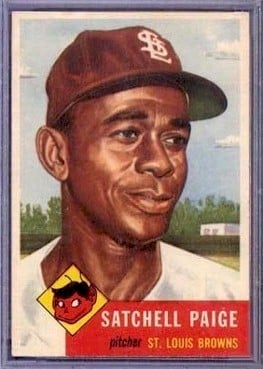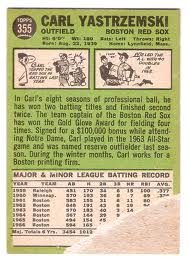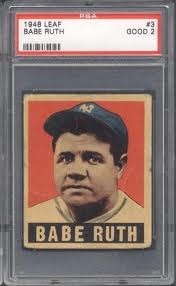With high grade Hall of Famers like Mickey Mantle commanding big bucks on the baseball card market, average collectors are looking for ways to stretch their dollar.* If you’re not buying mint or near mint, you’ll be buying a card that has some sort of defect.* Maybe more than one.* But is one defect worse than another?
Collectors talk a lot about ‘eye appeal’.* Maybe the card’s corners aren’t sharp enough for you to shave with.* That doesn’t mean it doesn’t look nice inside of a holder or inside the plastic pages that hold your set.
 Many collectors and dealers agree that the most important attribute any sports card can have is good centering.* If the picture is pushed to the far edge in any direction, it just looks strange.
Many collectors and dealers agree that the most important attribute any sports card can have is good centering.* If the picture is pushed to the far edge in any direction, it just looks strange.
All you have to do is open a pack of vintage cards and you can see that well centered cards are truly difficult to find.* Sure, you can sometimes find near mint to mint cards with blazing corners but if the card isn’t centered 70-30 or better it just doesn’t matter that much.
Collectors hate creases.* The good thing is that a card can have a ‘hairline’ or light crease and still be pretty attractive.* Many creases will significantly downgrade a card submitted to one of the grading services, even those that can’t be seen with a naked eye.** These types of cards can be incredible bargains if one is mainly concerned with…there’s that word again…eye appeal.
However, when it looks like it’s been folded a few times or bent for bike spokes, it may be ‘well loved’ but to most vintage collectors, it’s just ugly.* Not everyone subscribes to that idea, but on the defect scale, poor centering and creases are at the top of most collectors’ no-no lists.
Long before cards had monetary value, it was quite common and very much accepted to put your cards in a scrapbook with scotch tape or glue.* It’s left the descendants of early collectors who’ve pulled those books out decades later shaking their heads in dismay.* Certain chemicals can remove tape and glue but then you’re getting into the area of card “doctoring” and someti mes the end result isn’t pretty.
mes the end result isn’t pretty.
Paper loss is another common result of the above mentioned storage method.* While most paper loss happens on the back of a card, a true collector has a problem with a hunk of text missing from the bio of a 1933 Goudey because it was pulled off when someone tried to remove it from a scrapbook.
Those are some of the worst defects to deal with.* Others are little more palatable and these are the cards to focus on if you’re looking to build a set on a budget.
Sometimes the early printing process resulted in poor focus.* This is especially true on cards printed prior to the 1950s, although cards like the 1951 Berk Ross issue are notorious for it.* If the photo is fuzzy, you’ll spend the rest of the day trying to figure out if you need Lasik surgery.
Sometimes a card can have really nice corners, be well centered and crease free.* You get excited until you look a little closer.* Thanks to the dark backgrounds prevalent on many vintage cards, scuffing is common.* Even during the printing process, the ink can either be scuffed or lifted and what results are white specks or streaks that take away from what otherwise might be a very attractive card.
While not as common on cards from the 1950s and later, discoloration or soiling can turn a card that’s focused, well centered and crease free into a nasty shade of VG.** If you know of a non-invasive way to remove some of the dirt, you might wind up with something nice but if the card has been yellowed or otherwise had its hue changed, it won’t look right next to its binder neighbor that has those white borders.
 Most common among defects is corner wear.* It’s often the first thing mentioned when a seller describes a card.* Corner wear happens quite naturally and in cards of all types it’s the most common flaw.* The degree of corner wear is what often creates the difference between a “4″ and a “9″.** Wear of a degree that’s consistent on all four corners makes a card look uniform and is often more pleasing than a card with one bad corner and three good ones.
Most common among defects is corner wear.* It’s often the first thing mentioned when a seller describes a card.* Corner wear happens quite naturally and in cards of all types it’s the most common flaw.* The degree of corner wear is what often creates the difference between a “4″ and a “9″.** Wear of a degree that’s consistent on all four corners makes a card look uniform and is often more pleasing than a card with one bad corner and three good ones.
Baseball cards once came in wax packs and often that simple sealant turns a mint card into one that’s no better than excellent.* Few things are more heartbreaking to a collector than a big, bad wax stain on the back of a nice Mickey Mantle card.* If the backs don’t matter or if you think they add character by representing proof that a card is unaltered, they can be a big bargain.
There are other defects that show up, of course.* Liquid stains.* Nicks.* Printing flaws.* All impact the grade but it’s always good to remember that some issues are worse than others and knowing that can help you build a good-looking collection without going over budget.
More...
Collectors talk a lot about ‘eye appeal’.* Maybe the card’s corners aren’t sharp enough for you to shave with.* That doesn’t mean it doesn’t look nice inside of a holder or inside the plastic pages that hold your set.
 Many collectors and dealers agree that the most important attribute any sports card can have is good centering.* If the picture is pushed to the far edge in any direction, it just looks strange.
Many collectors and dealers agree that the most important attribute any sports card can have is good centering.* If the picture is pushed to the far edge in any direction, it just looks strange.All you have to do is open a pack of vintage cards and you can see that well centered cards are truly difficult to find.* Sure, you can sometimes find near mint to mint cards with blazing corners but if the card isn’t centered 70-30 or better it just doesn’t matter that much.
Collectors hate creases.* The good thing is that a card can have a ‘hairline’ or light crease and still be pretty attractive.* Many creases will significantly downgrade a card submitted to one of the grading services, even those that can’t be seen with a naked eye.** These types of cards can be incredible bargains if one is mainly concerned with…there’s that word again…eye appeal.
However, when it looks like it’s been folded a few times or bent for bike spokes, it may be ‘well loved’ but to most vintage collectors, it’s just ugly.* Not everyone subscribes to that idea, but on the defect scale, poor centering and creases are at the top of most collectors’ no-no lists.
Long before cards had monetary value, it was quite common and very much accepted to put your cards in a scrapbook with scotch tape or glue.* It’s left the descendants of early collectors who’ve pulled those books out decades later shaking their heads in dismay.* Certain chemicals can remove tape and glue but then you’re getting into the area of card “doctoring” and someti
 mes the end result isn’t pretty.
mes the end result isn’t pretty.Paper loss is another common result of the above mentioned storage method.* While most paper loss happens on the back of a card, a true collector has a problem with a hunk of text missing from the bio of a 1933 Goudey because it was pulled off when someone tried to remove it from a scrapbook.
Those are some of the worst defects to deal with.* Others are little more palatable and these are the cards to focus on if you’re looking to build a set on a budget.
Sometimes the early printing process resulted in poor focus.* This is especially true on cards printed prior to the 1950s, although cards like the 1951 Berk Ross issue are notorious for it.* If the photo is fuzzy, you’ll spend the rest of the day trying to figure out if you need Lasik surgery.
Sometimes a card can have really nice corners, be well centered and crease free.* You get excited until you look a little closer.* Thanks to the dark backgrounds prevalent on many vintage cards, scuffing is common.* Even during the printing process, the ink can either be scuffed or lifted and what results are white specks or streaks that take away from what otherwise might be a very attractive card.
While not as common on cards from the 1950s and later, discoloration or soiling can turn a card that’s focused, well centered and crease free into a nasty shade of VG.** If you know of a non-invasive way to remove some of the dirt, you might wind up with something nice but if the card has been yellowed or otherwise had its hue changed, it won’t look right next to its binder neighbor that has those white borders.
 Most common among defects is corner wear.* It’s often the first thing mentioned when a seller describes a card.* Corner wear happens quite naturally and in cards of all types it’s the most common flaw.* The degree of corner wear is what often creates the difference between a “4″ and a “9″.** Wear of a degree that’s consistent on all four corners makes a card look uniform and is often more pleasing than a card with one bad corner and three good ones.
Most common among defects is corner wear.* It’s often the first thing mentioned when a seller describes a card.* Corner wear happens quite naturally and in cards of all types it’s the most common flaw.* The degree of corner wear is what often creates the difference between a “4″ and a “9″.** Wear of a degree that’s consistent on all four corners makes a card look uniform and is often more pleasing than a card with one bad corner and three good ones.Baseball cards once came in wax packs and often that simple sealant turns a mint card into one that’s no better than excellent.* Few things are more heartbreaking to a collector than a big, bad wax stain on the back of a nice Mickey Mantle card.* If the backs don’t matter or if you think they add character by representing proof that a card is unaltered, they can be a big bargain.
There are other defects that show up, of course.* Liquid stains.* Nicks.* Printing flaws.* All impact the grade but it’s always good to remember that some issues are worse than others and knowing that can help you build a good-looking collection without going over budget.
More...